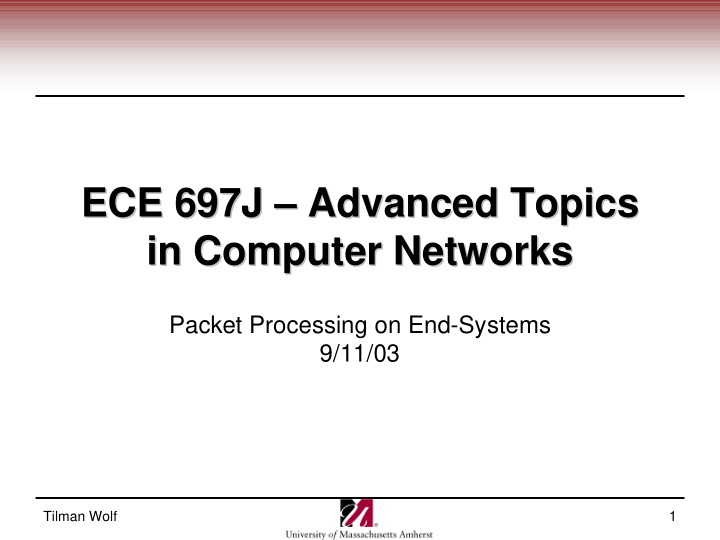



ECE 697J – – Advanced Topics Advanced Topics ECE 697J in Computer Networks in Computer Networks Packet Processing on End-Systems 9/11/03 Tilman Wolf 1
Network Systems Network Systems • The obvious: hosts and routers • Hosts can be variety of devices: – Workstations, servers, wireless PDAs, cell phones, etc. • But there is more on different layers Tilman Wolf 2
Layer 2 Devices Layer 2 Devices • Bridges: – Connection between two networks on data link level – Isolation of Ethernet collision domains • Layer 2 switch: – Similar to bridge – Often with point-to-point connections on each port – High-throughput • VLAN switch: – Supports several Virtual LANs – Layer 2 switch that emulates several smaller switches Tilman Wolf 3
Layer 3 & 4 Devices Layer 3 & 4 Devices • IP Router – Packet forwarding – IP destination address lookup, simple packet header processing • Firewall – Blocks packets to certain internal addresses and ports – Maintains list of currently active connections • Network Address Translator (NAT) – “Hides” subnet behind single external IP address – Rewrites packets to change IP address and port numbers • Load Balancer – Distributes web requests to server farm – Uses Layer 4+ (or Layer 7) classification and TCP splicing • Set-Top Box – Decrypts content for service subscribers • Other devices: Monitor, Policer, Shaper, Analyzer Tilman Wolf 4
Packet Processing on Host Packet Processing on Host • “Conventional Computer System”: – Single CPU, memory, 1+ I/O devices, bus interconnect • Network Interface Card (NIC) used for communication Tilman Wolf 5
Bus Interconnect Bus Interconnect • Bus is parallel set of wires to which devices connect: • Address is location of data • Control indicates valid data, read or write, etc. • Bus bandwidth determined by width and bus frequency – Bus BW = width * bus frequency • Example: PCI bus on PC: 32 bits 66MHz • How to destinguish reads and writes to different devices? Tilman Wolf 6
Bus Address Space Bus Address Space • Addresses “code” device information – Each device gets a unique set of addresses – Address space depends on application – Not entire address space needs to be allocated Tilman Wolf 7
Other Bus Issues Other Bus Issues • Busses implement “fetch-store paradigm” – A bus operation is either a load (fetch) or a store – nothing else • Control operations can be encoded as load/store ops – How? • Real busses are more complicated – Bus arbiter implements access rules (e.g., priorities) – Some busses allow split-transaction – Some busses transfer data on each edge of the clock – Etc. • For us: bus is necessary to communicate between CPU and NIC Tilman Wolf 8
NIC Functionality NIC Functionality • NIC implements Layer 1 and 2 functionality – Sends and receives frames correctly • Packet transmission: – CPU assembles packet in memory (typically including layer 2 header) – CPU transmits packet in chunks over bus to NIC – NIC buffers packet and sends it into the network • Packet reception: – NIC has assigned buffer space – On packet arrival, packet is stored in that buffer – NIC informs CPU about packet • Several inefficiencies! Tilman Wolf 9
NIC Optimization NIC Optimization • Onboard address recognition and filtering – Recognition of unicast and broadcast addresses – Multicast addresses more complex, why? – Multicast addresses are configured by CPU and limited • Onboard packet buffering – NIC has memory to buffer packets, why? – Bursty traffic and contention on bus interconnect can require buffering – NIC can receive packets while transferring others to CPU • Direct Memory Access (DMA) – Transfer of large amounts of data directly to/from memory – No CPU involvement – CPU tells NIC the location of buffer in memory Tilman Wolf 10
Operation and Data Chaining Operation and Data Chaining • CPU sets up linked list of buffers – NIC fills buffers as data comes in: • “Command” in each buffer specifies receive or transmit • Extra bit indicates if NIC has completed transfer Tilman Wolf 11
Data Chaining Data Chaining • Data chaining used also in operating systems • Unix BSD packet mbufs: Tilman Wolf 12
Data Flow Diagrams Data Flow Diagrams • Illustration of data path: • Side note: – In PC systems, the PCI bus is the bottleneck of the system Tilman Wolf 13
Next Class Next Class • Packet processing functions • Various data structures and algorithms – Table lookups and hashing – IP fragmentation and reassembly – IP forwarding – TCP connection recognition – TCP splicing • Paper assignment – Who wants what? Tilman Wolf 14
Papers Papers • IP lookup: Marcel Waldvogel, George Varghese, Jon Turner, Bernhard Plattner. Scalable High Speed IP Lookups. In Proc. of ACM SIGCOMM 97, pages 25-36, Cannes, France, September 1997. • Router design: S. Keshav and Rosen Sharma. Issues and Trends in Router Design. IEEE Communications Magazine, 36(5):144-151, May 1998. • Network applications (1): George Apostolopoulos, David Aubespin, Vinod Peris, Prashant Pradhan, Debanjan Saha. Design, Implementation and Performance of a Content-Based Switch. In Proc. of IEEE INFOCOM 2000, pages 1117-1126, Tel Aviv, Israel, March 2000. • Network applications (2): Li-wei Lehman, Stephen J. Garland, and David L. Tennenhouse. Active reliable multicast. In Proc. of IEEE INFOCOM 98, pages 581-589, San Francisco, CA, April 1998. • Active networking: David L. Tennenhouse and David J. Wetherall. Towards an active network architecture. Computer Communication Review, 26(2):5-18, April 1996. • Scheduling: M. Shreedhar and George Varghese. Efficient fair queuing using deficit round-robin. IEEE/ACM Transactions on Networking, 4(3): 375- 385, June 1996. Tilman Wolf 15
Recommend
More recommend